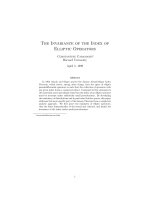index of cnpmpth02004thamkhao
Bạn đang xem bản rút gọn của tài liệu. Xem và tải ngay bản đầy đủ của tài liệu tại đây (432.18 KB, 39 trang )
<span class='text_page_counter'>(1)</span><div class='page_container' data-page=1>
Graphs
<b>Today</b>
</div>
<span class='text_page_counter'>(2)</span><div class='page_container' data-page=2>
What is a graph?
• Graphs represent the relationships among data
items
• A graph G consists of
– a set V of nodes (vertices)
– a set E of edges: each edge connects two nodes
• Each node represents an item
• Each edge represents the relationship between
two items
node
edge
Examples of graphs
H
H
C H
H
Molecular Structure
Server 1
Server 2
Terminal 1
Terminal 2
Computer Network
</div>
<span class='text_page_counter'>(3)</span><div class='page_container' data-page=3>
Formal Definition of graph
• The set of nodes is denoted as V
• For any nodes u and v, if u and v are
connected by an edge, such edge is denoted
as (u, v)
• The set of edges is denoted as E
• A graph G is defined as a pair (V, E)
v
u
(u, v)
Adjacent
• Two nodes u and v are said to be
adjacent
if (u, v)
∈
E
v
w
u
(u, v)
u and v are adjacent
</div>
<span class='text_page_counter'>(4)</span><div class='page_container' data-page=4>
Path and simple path
• A
path
from v
<sub>1</sub>to v
<sub>k</sub>is a sequence of
nodes v
<sub>1</sub>, v
<sub>2</sub>, …, v
<sub>k</sub>that are connected by
edges (v
<sub>1</sub>, v
<sub>2</sub>), (v
<sub>2</sub>, v
<sub>3</sub>), …, (v
<sub>k-1</sub>, v
<sub>k</sub>)
• A path is called a
simple path
if every
node appears at most once.
v
<sub>1</sub>v
2v
<sub>4</sub>v
<sub>3</sub>v
<sub>5</sub>- v<sub>2, </sub>v<sub>3, </sub>v<sub>4, </sub>v<sub>2, </sub>v<sub>1</sub> is a path
- v<sub>2, </sub>v<sub>3, </sub>v<sub>4, </sub>v<sub>5</sub> is a path, also
it is a simple path
Cycle and simple cycle
• A
cycle
is a path that begins and ends at
the same node
• A
simple cycle
is a cycle if every node
appears at most once, except for the first
and the last nodes
v
<sub>1</sub>v
2v
<sub>4</sub>v
<sub>3</sub>v
<sub>5</sub></div>
<span class='text_page_counter'>(5)</span><div class='page_container' data-page=5>
Connected graph
• A graph G is
connected
if there exists path
between every pair of distinct nodes;
otherwise, it is
disconnected
v
<sub>1</sub>v
<sub>4</sub>v
<sub>3</sub>v
<sub>5</sub>v
<sub>2</sub>This is a connected graph because there exists path
between every pair of nodes
Example of disconnected graph
v
<sub>1</sub>v
<sub>4</sub>v
<sub>3</sub>v
<sub>5</sub>v
<sub>2</sub>This is a disconnected graph because there does not
exist path between some pair of nodes, says, v<sub>1</sub> and v<sub>7</sub>
v
<sub>7</sub>v
<sub>6</sub>v
<sub>8</sub></div>
<span class='text_page_counter'>(6)</span><div class='page_container' data-page=6>
Connected component
• If a graph is disconnect, it can be partitioned into
a number of graphs such that each of them is
connected. Each such graph is called a
connected component.
v
<sub>1</sub>v
<sub>4</sub>v
<sub>3</sub>v
<sub>5</sub>v
<sub>2</sub>v
<sub>7</sub>v
<sub>6</sub>v
<sub>8</sub>v
<sub>9</sub>Complete graph
• A graph is
complete
if each pair of distinct
nodes has an edge
Complete graph
</div>
<span class='text_page_counter'>(7)</span><div class='page_container' data-page=7>
Subgraph
• A
subgraph
of a graph G =(V, E) is a
graph H = (U, F) such that U
⊆
V and
F
⊆
E.
v
<sub>1</sub>v
<sub>4</sub>v
<sub>3</sub>v
<sub>5</sub>v
<sub>2</sub>G
v
<sub>4</sub>v
<sub>3</sub>v
<sub>5</sub>v
<sub>2</sub>H
Weighted graph
• If each edge in G is assigned a weight, it is
called a
weighted graph
Houston
Chicago <sub>1000</sub>
2000 3500
</div>
<span class='text_page_counter'>(8)</span><div class='page_container' data-page=8>
Directed graph (digraph)
• All previous graphs are undirected graph
• If each edge in E has a direction, it is called a directed
edge
• A directed graph is a graph where every edges is a
directed edge
Directed edge
Houston
Chicago <sub>1000</sub>
2000 <sub>3500</sub>
New York
More on directed graph
• If (x, y) is a directed edge, we say
– y is adjacent to x
– y is successor of x
– x is predecessor of y
• In a directed graph,
directed path
,
directed
cycle
can be defined similarly
</div>
<span class='text_page_counter'>(9)</span><div class='page_container' data-page=9>
Multigraph
• A graph cannot have duplicate edges.
• Multigraph allows
multiple edges
and
self
edge
(or
loop
).
Multiple edge
Self edge
Property of graph
• A undirected graph that is connected and
has no cycle is a tree.
• A tree with n nodes have exactly n-1
edges.
</div>
<span class='text_page_counter'>(10)</span><div class='page_container' data-page=10>
Implementing Graph
• Adjacency matrix
– Represent a graph using a two-dimensional
array
• Adjacency list
– Represent a graph using n linked lists where
n is the number of vertices
Adjacency matrix for directed graph
v
<sub>1</sub>v
<sub>4</sub>v
<sub>3</sub>v
<sub>5</sub>v
<sub>2</sub>G
1 2 3 4 5
v<sub>1</sub> v<sub>2</sub> v<sub>3</sub> v<sub>4</sub> v<sub>5</sub>
1 v<sub>1</sub> 0 1 0 0 0
2 v<sub>2</sub> 0 0 0 1 0
3 v<sub>3</sub> 0 1 0 1 0
4 v<sub>4</sub> 0 0 0 0 0
5 v<sub>5</sub> 0 0 1 1 0
</div>
<span class='text_page_counter'>(11)</span><div class='page_container' data-page=11>
Adjacency matrix for weighted
undirected graph
v
<sub>1</sub>v
<sub>4</sub>v
<sub>3</sub>v
<sub>5</sub>v
<sub>2</sub>G
1 2 3 4 5
v<sub>1</sub> v<sub>2</sub> v<sub>3</sub> v<sub>4</sub> v<sub>5</sub>
1 v<sub>1</sub> ∞ 5 ∞ ∞ ∞
2 v<sub>2</sub> 5 ∞ 2 4 ∞
3 v<sub>3</sub> 0 2 ∞ 3 7
4 v<sub>4</sub> ∞ 4 3 ∞ 8
5 v<sub>5</sub> ∞ ∞ 7 8 ∞
Matrix[i][j] = w(v<sub>i</sub>, v<sub>j</sub>) if (v<sub>i</sub>, v<sub>j</sub>)∈E or (v<sub>j</sub>, v<sub>i</sub>)∈E
∞ otherwise
5 2
3 <sub>7</sub>
8
4
Adjacency list for directed graph
v
<sub>1</sub>v
<sub>4</sub>v
<sub>3</sub>v
<sub>5</sub>v
<sub>2</sub>G
1 v<sub>1</sub> → v<sub>2</sub>
2 v<sub>2</sub> → v<sub>4</sub>
3 v<sub>3</sub> → v<sub>2</sub> → v<sub>4</sub>
4 v<sub>4</sub>
</div>
<span class='text_page_counter'>(12)</span><div class='page_container' data-page=12>
Adjacency list for weighted
undirected graph
v
<sub>1</sub>v
<sub>4</sub>v
<sub>3</sub>v
<sub>5</sub>v
<sub>2</sub>G
5 2
3 <sub>7</sub>
8
4
1 v<sub>1</sub> → v<sub>2</sub>(5)
2 v<sub>2</sub> → v<sub>1</sub>(5) → v<sub>3</sub>(2) → v<sub>4</sub>(4)
3 v<sub>3</sub> → v<sub>2</sub>(2) → v<sub>4</sub>(3) → v<sub>5</sub>(7)
4 v<sub>4</sub> → v<sub>2</sub>(4) → v<sub>3</sub>(3) → v<sub>5</sub>(8)
5 v<sub>5</sub> → v<sub>3</sub>(7) → v<sub>4</sub>(8)
Pros and Cons
• Adjacency matrix
– Allows us to determine whether there is an
edge from node i to node j in O(1) time
• Adjacency list
– Allows us to find all nodes adjacent to a given
node j efficiently
</div>
<span class='text_page_counter'>(13)</span><div class='page_container' data-page=13>
Problems related to Graph
• Graph Traversal
• Topological Sort
• Spanning Tree
• Minimum Spanning Tree
• Shortest Path
Graph Traversal Algorithm
• To traverse a tree, we use tree traversal
algorithms like pre-order, in-order, and
post-order to visit all the nodes in a tree
• Similarly, graph traversal algorithm tries to visit
all the nodes it can reach.
• If a graph is disconnected, a graph traversal that
begins at a node v will visit only a subset of
</div>
<span class='text_page_counter'>(14)</span><div class='page_container' data-page=14>
Two basic traversal algorithms
• Two basic graph traversal algorithms:
– Depth-first-search (DFS)
• After visit node v, DFS strategy proceeds along a
path from v as deeply into the graph as possible
before backing up
– Breadth-first-search (BFS)
• After visit node v, BFS strategy visits every node
adjacent to v before visiting any other nodes
Breadth-first search
• One of the simplest algorithms
• Also one of the most important
</div>
<span class='text_page_counter'>(15)</span><div class='page_container' data-page=15>
BFS: Level-by-level traversal
• Given a starting vertex s
• Visit all vertices at increasing distance
from s
– Visit all vertices at distance k from s
– Then visit all vertices at distance k+1 from s
– Then ….
BFS in a binary tree (reminder)
BFS: visit all siblings before their descendents
5
2
1 3
8
6 <sub>10</sub>
7 9
</div>
<span class='text_page_counter'>(16)</span><div class='page_container' data-page=16>
BFS(tree t)
1. NodePrt curr;
2. Queue q;
3. initialize(q);
4. Insert(q,t);
5. while (not Isempty(q))
6. curr = delete(q)
7. visit curr // e.g., print curr.datum
8. insert(q, curr->left)
9. insert(q, curr->right)
<b>This version for binary trees only!</b>
BFS for general graphs
• This version assumes vertices have two
children
– left, right
– This is trivial to fix
• But still no good for general graphs
• It does not handle cycles
</div>
<span class='text_page_counter'>(17)</span><div class='page_container' data-page=17>
Start with A. Put in the queue (marked
red
)
A
B
G C
E
D
F
Queue: A
B and E are next
A
B
G C
E
D
F
</div>
<span class='text_page_counter'>(18)</span><div class='page_container' data-page=18>
When we go to B, we put G and C in the queue
When we go to E, we put D and F in the queue
A
B
G C
E
D
F
Queue:
A
B E C G D F
When we go to B, we put G and C in the queue
When we go to E, we put D and F in the queue
A
B
G C
E
D
F
</div>
<span class='text_page_counter'>(19)</span><div class='page_container' data-page=19>
Suppose we now want to expand C.
We put F in the queue again!
A
B
G C
E
D
F
Queue:
A B E C
G D F F
Generalizing BFS
• Cycles:
• We need to save auxiliary information
• Each node needs to be marked
– Visited: No need to be put on queue
– Not visited: Put on queue when found
</div>
<span class='text_page_counter'>(20)</span><div class='page_container' data-page=20>
The general BFS algorithm
• Each vertex can be in one of three states:
– Unmarked and not on queue
– Marked and on queue
– Marked and off queue
• The algorithm moves vertices between these
states
Handling vertices
• Unmarked and not on queue:
– Not reached yet
• Marked and on queue:
– Known, but adjacent vertices not visited yet
(possibly)
• Marked and off queue:
</div>
<span class='text_page_counter'>(21)</span><div class='page_container' data-page=21>
Start with A. Mark it.
A
B
G C
E
D
F
Queue: A
Expand A’s adjacent vertices.
Mark them and put them in queue.
A
B
G C
E
D
F
</div>
<span class='text_page_counter'>(22)</span><div class='page_container' data-page=22>
Now take B off queue, and queue its
neighbors.
A
B
G C
E
D
F
Queue:
A B
E C G
Do same with E.
A
B
G C
E
D
F
</div>
<span class='text_page_counter'>(23)</span><div class='page_container' data-page=23>
Visit C.
Its neighbor F is already marked, so not
queued.
A
B
G C
E
D
F
Queue:
A B E C
G D F
Visit G.
A
B
G C
E
D
F
</div>
<span class='text_page_counter'>(24)</span><div class='page_container' data-page=24>
Visit D. F, E marked so not queued.
A
B
G C
E
D
F
Queue:
A B E C G D
F
Visit F.
E, D, C marked, so not queued again.
A
B
G C
E
D
F
</div>
<span class='text_page_counter'>(25)</span><div class='page_container' data-page=25>
Done. We have explored the graph in order:
A B E C G D F.
A
B
G C
E
D
F
Queue:
A B E C G D F
Breadth-first search (BFS)
• BFS strategy looks similar to level-order. From a
given node v, it first visits itself. Then, it visits
every node adjacent to v before visiting any
other nodes.
– 1. Visit v
– 2. Visit all v’s neigbours
– 3. Visit all v’s neighbours’ neighbours
– …
</div>
<span class='text_page_counter'>(26)</span><div class='page_container' data-page=26>
BFS(graph g, vertex s)
<b>1. unmark all vertices in G;</b>
<b>2. Creat a queue q;</b>
<b>3. mark s;</b>
<b>4. insert(s,q)</b>
<b>5. while (!isempty(q))</b>
<b>6.</b> <b>curr = delete(q);</b>
<b>7.</b> <b>visit curr; // e.g., print its data</b>
<b>8.</b> <b>for each edge <curr, V></b>
<b>9.</b> <b>if V is unmarked</b>
<b>10.</b> <b>mark V;</b>
<b>11.</b> <b>insert(V,q);</b>
BFS example
• Start from v<sub>5</sub>
v
<sub>5</sub>1
v
<sub>3</sub>2
v
<sub>4</sub> 3v
<sub>2</sub>4
v
<sub>1</sub>5
v
<sub>1</sub>v
<sub>4</sub>v
<sub>3</sub>v
<sub>5</sub>v
<sub>2</sub>G
<b>x</b>
Visit Queue
(front to
back)
v<sub>5</sub> v<sub>5</sub>
empty
v<sub>3</sub> v<sub>3</sub>
v<sub>4</sub> v<sub>3</sub>, v<sub>4</sub>
v<sub>4</sub>
v<sub>2</sub> v<sub>4</sub>, v<sub>2</sub>
v<sub>2</sub>
empty
v<sub>1</sub> v<sub>1</sub>
empty
<b>x</b>
<b>x</b>
</div>
<span class='text_page_counter'>(27)</span><div class='page_container' data-page=27>
Interesting features of BFS
• Complexity: O(|V| + |E|)
– All vertices put on queue exactly once
– For each vertex on queue, we expand its edges
– In other words, we traverse all edges once
• BFS finds shortest path from s to each
vertex
– Shortest in terms of number of edges
– Why does this work?
Depth-first search
• Again, a simple and powerful algorithm
• Given a starting vertex s
• Pick an adjacent vertex, visit it.
– Then visit one of its adjacent vertices
– …..
</div>
<span class='text_page_counter'>(28)</span><div class='page_container' data-page=28>
DFS(graph g, vertex s)
<b>Assume all vertices initially </b>
<b>unmarked</b>
<b>1. mark s;</b>
<b>2. visit s; </b>
<b>// e.g., print its data</b>
<b>3. for each edge <s, V></b>
<b>4.</b>
<b>if V is not marked</b>
<b>5.</b>
<b>DFS(G, V);</b>
Start with A. Mark it.
A
B
G C
E
D
F
</div>
<span class='text_page_counter'>(29)</span><div class='page_container' data-page=29>
Expand A’s adjacent vertices. Pick one (B).
Mark it and re-visit.
A
B
G C
E
D
F
Current: B
Now expand B, and visit its neighbor, C.
A
B
G C
E
D
F
</div>
<span class='text_page_counter'>(30)</span><div class='page_container' data-page=30>
Visit F.
Pick one of its neighbors, E.
A
B
G C
E
D
F
Current: F
E’s adjacent vertices are A, D and F.
A and F are marked, so pick D.
A
B
G C
E
D
F
</div>
<span class='text_page_counter'>(31)</span><div class='page_container' data-page=31>
Visit D. No new vertices available. Backtrack to
E. Backtrack to F. Backtrack to C. Backtrack to B
A
B
G C
E
D
F
Current: D
Visit G. No new vertices from here. Backtrack to
B. Backtrack to A. E already marked so no new.
A
B
G C
E
D
F
</div>
<span class='text_page_counter'>(32)</span><div class='page_container' data-page=32>
Done. We have explored the graph in order:
A B C F E D G
A
B
G C
E
D
F
Current:
1
2
3
4
6
7
5
Interesting features of DFS
• Complexity: O(|V| + |E|)
– All vertices visited once, then marked
– For each vertex on queue, we examine all
edges
– In other words, we traverse all edges once
• DFS does not necessarily find shortest path
</div>
<span class='text_page_counter'>(33)</span><div class='page_container' data-page=33>
Depth-first search (DFS)
• DFS strategy looks similar to pre-order. From a given
node v, it first visits itself. Then, recursively visit its
unvisited neighbours one by one.
• DFS can be defined recursively as follows.
<b>Algorithm DFS(v)</b>
printf v; // you can do other things!
mark v as visited;
for (each unvisited node u adjacent to v)
DFS(u);
DFS example
• Start from v
<sub>3</sub>v
<sub>1</sub>v
<sub>4</sub>v
<sub>3</sub>v
<sub>5</sub>v
<sub>2</sub>G
v
<sub>3</sub>1
v
<sub>2</sub>2
v
<sub>1</sub>3
v
<sub>4</sub>4
v
<sub>5</sub> 5<b>x</b>
<b>x</b>
<b>x</b>
</div>
<span class='text_page_counter'>(34)</span><div class='page_container' data-page=34>
Non-recursive version of DFS
algorithm
<b>Algorithm dfs(v)</b>
Initialize(s);
push(v,s);
mark v as visited;
while (!isEmpty(s)) {
let x be the node on the top of the stack s;
if (no unvisited nodes are adjacent to x)
pop(s); // blacktrack
else {
select an unvisited node u adjacent to x;
push(u,s);
mark u as visited;
}
}
Non-recursive DFS example
v
<sub>1</sub>v
<sub>4</sub>v
<sub>3</sub>v
<sub>5</sub>v
<sub>2</sub>G
visit stack
v<sub>3</sub> v<sub>3</sub>
v<sub>2</sub> v<sub>3</sub>, v<sub>2</sub>
v<sub>1</sub> v<sub>3</sub>, v<sub>2</sub>, v<sub>1</sub>
backtrack v<sub>3</sub>, v<sub>2</sub>
v<sub>4</sub> v<sub>3</sub>, v<sub>2</sub>, v<sub>4</sub>
v<sub>5</sub> v<sub>3</sub>, v<sub>2</sub>, v<sub>4 </sub>, v<sub>5</sub>
backtrack <sub>v</sub><sub>3</sub><sub>, v</sub><sub>2</sub><sub>, v</sub><sub>4 </sub>
backtrack v<sub>3</sub>, v<sub>2</sub>
backtrack <sub>v</sub><sub>3</sub>
backtrack empty
<b>x</b>
<b>x</b>
<b>x</b>
</div>
<span class='text_page_counter'>(35)</span><div class='page_container' data-page=35>
Topological order
• Consider the prerequisite structure for courses:
• Each node x represents a course x
• (x, y) represents that course x is a prerequisite to course y
• Note that this graph should be a directed graph without cycles
(called a directed acyclic graph).
• A linear order to take all 5 courses while satisfying all prerequisites
is called a topological order.
• E.g.
– a, c, b, e, d
– c, a, b, e, d
b <sub>d</sub>
e
c
a
Topological Sort
• Topological sort: ordering of vertices in a
directed acyclic graph such that if there is a path
from vi to vj then vj appears after vi in the
ordering
• Application: scheduling jobs.
– Each job is a vertex in a graph, and there is an edge
from <i>x</i> to <i>y</i> if job <i>x</i> must be completed before job <i>y</i> can
be done.
– topological sort gives the order in which to perform
the jobs.
</div>
<span class='text_page_counter'>(36)</span><div class='page_container' data-page=36>
Topological Sort
7 5 3
2
8
11
10
9
Topological sorts:
7, 5, 3, 11, 8, 2, 10, 9
5, 7, 3, 11, 8, 2, 10, 9
5, 7, 11, 2, 3, 8, 9, 10
Topological sort
• Arranging all nodes in the graph in a topological
order
<b>Algorithm topSort1</b>
n = |V|;
for i = 1 to n {
select a node v that has no successor (no outgoing
edge);
print this vertex;
</div>
<span class='text_page_counter'>(37)</span><div class='page_container' data-page=37>
Example
b <sub>d</sub>
e
c
a
1. d has no
successor!
Choose d!
a
5. Choose a!
The topological order
is<b>a,b,c,e,d</b>
2. Both b and e have no
successor! Choose e!
b
e
c
a
3. Both b and c have
no successor!
Choose c!
b
c
a
4. Only b has no
successor!
Choose b!
b
a
Topological sort
• Arranging all nodes in the graph in a topological
order
<b>Algorithm topSort2</b>
n = |V|;
for i = 1 to n {
select a node v that has no ancestors (no incoming
edges);
print this vertex;
</div>
<span class='text_page_counter'>(38)</span><div class='page_container' data-page=38>
Example
b <sub>d</sub>
e
c
a
1. a has no
ancestors!
Choose a!
e
5. Choose e!
The topological order
is<b>a,b,c,e,d</b>
2. Both b and c have no
ancestosr! Choose b!
3. Only c has no
ancestors! Choose
c!
4. Only e has no
ancestors!
Choose !
b <sub>d</sub>
e
c
d
e
c
d
e
Topological Sorting
• What happens if graph has a cycle?
– Topological ordering is not possible
– For two vertices v & w, v precedes w and w precedes
v
• Topological sorts can have more than one
ordering
1 2
3
</div>
<span class='text_page_counter'>(39)</span><div class='page_container' data-page=39>
Topological Sorting
L ← Empty list that will contain the sorted elements
S ← Set of all nodes with no incoming edges
<b>while</b> S is non-empty <b>do</b>
remove a node n from S
insert n into L
<b>for each</b> node m with an edge <i>e</i> from n to m <b>do</b>
remove edge e from the graph
<b>if</b> m has no other incoming edges <b>then</b>
insert m into S
<b>if</b> graph has edges <b>then</b>
output error message (graph has at least one cycle)
<b>else</b>
output message (proposed topologically sorted order: L)
Topological sort algorithm 2
• This algorithm is based on DFS
<b>Algorithm topSort2</b>
createStack(s);
for (all nodes v in the graph) {
if (v has no incomming edges) {
push(v,s);
mark v as visited;
}
}
while (!isEmpty(s)) {
let x be the node on the top of the stack s;
if (no unvisited nodes are adjacent to x){ // i.e. x has no unvisited successor
printf x;
pop(s);// blacktrack
} else {
select an unvisited node u adjacent to x;
push(u,s);
mark u as visited;
}
}
</div>
<!--links-->









